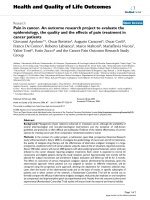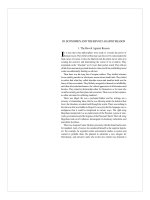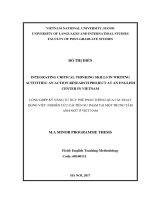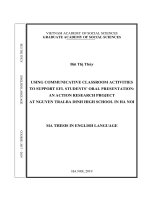Lecture Planning an applied research project in hospitality, tourism, and sports: Chapter 3 - Mayo
Bạn đang xem bản rút gọn của tài liệu. Xem và tải ngay bản đầy đủ của tài liệu tại đây (421.33 KB, 22 trang )
Planning an
Applied Research
Project
Chapter 3 – Conducting a Literature
Review
© 2014 by John Wiley & Sons, Inc. All rights reserved.
Learning Objectives
» Compare insights from various scholarly articles
» Develop a clear purpose statement and research
questions
» Make a case for your purpose statement and
research questions
» Take notes in a manner useful to conducting a
literature review
© 2014 by John Wiley & Sons, Inc. All rights reserved.
Key Terms
»
»
»
»
»
»
»
»
Abstract
Annotation
Annotated bibliography
Bibliographical tools
Literature review
Order of reading a scholarly article
Purpose of a literature review
Perspective
© 2014 by John Wiley & Sons, Inc. All rights reserved.
Definition of a Literature Review
» Description of the major findings in studies focusing
on a particular topic
» Comparison of insights from various articles and
different authors
» Picture of the patterns and gaps of scholarship on a
topic
» Coherent essay synthesizing current scholarship
© 2014 by John Wiley & Sons, Inc. All rights reserved.
Purposes of a Literature Review
»
»
»
»
»
»
»
»
Provides background to your research design
Demonstrates patterns of research
Builds credibility for your design
Prevents rediscovering the wheel
Benefits from others’ work
Expands your thinking of the purpose statement
Assists in the analysis of your findings
Makes a case for your purpose statement and
research questions
© 2014 by John Wiley & Sons, Inc. All rights reserved.
Finding Scholarly Articles
» Review your research questions and purpose
statement
» Come up with key words and phrases that fit your
purpose statement and research questions
» Search on your library website or using your local
search engine to find articles
» Review the abstracts of the articles
» Save the ones that seem relevant
© 2014 by John Wiley & Sons, Inc. All rights reserved.
Finding Scholarly Articles
(cont’d)
» Start to build a bibliography of articles for your
literature review
» Use one bibliography to give you names to search
and titles of other articles
» Save the articles (at least the references) during
this part of the search
» Recognize that a wider net works better
© 2014 by John Wiley & Sons, Inc. All rights reserved.
Finding Scholarly Articles
(cont’d)
» Consider synonyms of key words from your
purpose statement and research questions
» Read abstracts of articles for key words
» Look in bibliographies for current scholar’s names
» Contemplate parallel topics and studies
» Conduct interviews of faculty members or others
who know the field to find out key articles
© 2014 by John Wiley & Sons, Inc. All rights reserved.
Order of Reading Scholarly
Journal Articles
© 2014 by John Wiley & Sons, Inc. All rights reserved.
Order of Reading Scholarly
Journal Articles (cont’d)
» Many people typically follow the pattern of:
˃ Abstract
˃ Introduction
˃ Literature review
˃ Research design (sometimes called Method)
˃ Research results and key findings
˃ Analysis (sometimes called Discussion)
˃ Applications
˃ Limitations and Opportunities for more research
˃ Conclusion or Summary
© 2014 by John Wiley & Sons, Inc. All rights reserved.
Order of Reading Scholarly
Journal Articles (cont’d)
» A more efficient method is:
˃ Abstract
˃ Introduction
˃ Conclusion or Summary
˃ Research results and key findings
˃ Limitations and Opportunities for more research
˃ Applications
˃ Research design (sometimes called Method)
˃ Analysis (sometimes called Discussion)
˃ Literature review
˃ Introduction (again)
˃ Full reading of entire article
© 2014 by John Wiley & Sons, Inc. All rights reserved.
What to Look for When Reading
Articles
»
»
»
»
»
Insights or findings
Type of research – quantitative, qualitative, mixed
Structure of the research design
Use of pilot study
Research techniques – survey, questionnaire,
experiment, focus group, observation, content
analysis
© 2014 by John Wiley & Sons, Inc. All rights reserved.
What to Look for When Reading
Articles (cont’d)
»
»
»
»
»
»
Type of sample
Demographics of the sample
Statistical methods of analysis
Limitations of the study
Suggestions for future research
Dates of works cited in the bibliography
© 2014 by John Wiley & Sons, Inc. All rights reserved.
Taking Notes as You Read
» Read an article fast
» Complete two annotated bibliography paragraphs
˃ Summary
˃ Assessment
˃ Other comments
» For each finding, write a paragraph and put the
footnote in MLA or APA format at the bottom of the
page (Mayo 545) or (Mayo 2013)
» Use separate pages on your computer
© 2014 by John Wiley & Sons, Inc. All rights reserved.
Taking Notes as You Read
(cont’d)
˃ Topics for note paragraphs:
˃ Methods
˃ Findings
˃ Limitations
˃ Sampling
˃ Validity
˃ Opportunities
˃ Contexts
» Write as many paragraphs as you think relevant or
interesting or potentially valuable
© 2014 by John Wiley & Sons, Inc. All rights reserved.
Taking Notes as You Read
(cont’d)
» Make several copies of these notes
» Start a back up file
» After a few notes, write a paragraph or several and
save it
» Write early and often
© 2014 by John Wiley & Sons, Inc. All rights reserved.
Evaluating Articles
» Did they have an appropriate way of drawing those
conclusions from the data they collected and the
ways they were analyzed?
» Are there qualifications to the statements that they
can make from their research?
» What qualifications should they have made?
» What limitations did they mention?
» What limitations did they fail to point out or other
limitations you identified?
» What generalizations do they draw and can they
draw from what they discovered?
© 2014 by John Wiley & Sons, Inc. All rights reserved.
Preparing an Annotated
Bibliography
Literature Review
Annotated Bibliography
» A coherent essay
» Assessment of a field
of inquiry or area of
research
» Written to build
credibility for the article,
proposal, or report
» Organized according to
the logic of the
argument
» A few paragraphs
» Overall assessment of
a single article or
document
» Written to provide
future resource advice
for scholars and
researchers
» Organized according to
alphabetical names
© 2014 by John Wiley & Sons, Inc. All rights reserved.
Preparing an Annotated
Bibliography (cont’d)
˃ Three parts
C A full citation in correct MLA format
S A summary of the contents of the article,
book, website, or other document or source
(including interviews)
A An assessment, evaluation, critique of the
merits, validity, or usefulness of the source
˃ Summary and comments indented after the
bibliographical citation and in single spaced
format
© 2014 by John Wiley & Sons, Inc. All rights reserved.
Making a Literature Review
Effective and Interesting to Do
» Consider what aspects of the subject might be
studied and what the investigators might have
found from their work.
» Explore key authors in the article’s bibliography.
» Investigate parallel organizations or situations.
» Play with words that might serve as search terms.
© 2014 by John Wiley & Sons, Inc. All rights reserved.
The Research Hourglass
»
»
»
»
»
»
»
»
»
»
»
»
Topic
Purpose statement
Research questions
Literature review
Research design
Research method
Data analysis plan
Findings
Applications
Limitations
Opportunities
Conclusions
© 2014 by John Wiley & Sons, Inc. All rights reserved.
Review of the Class Session
» Anything unclear?
» One thing that surprised me to learn from this class
is …
© 2014 by John Wiley & Sons, Inc. All rights reserved.









